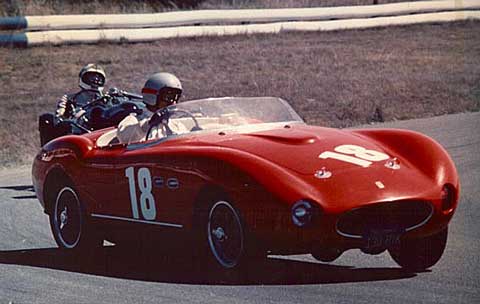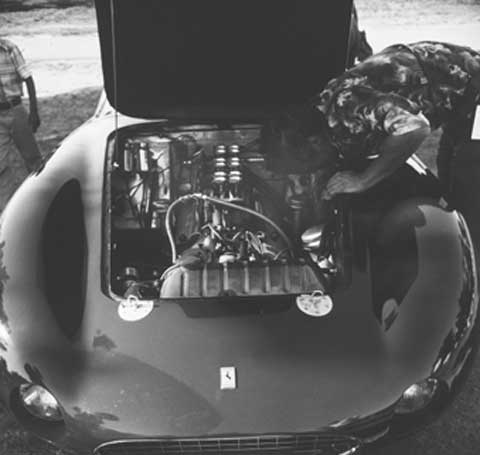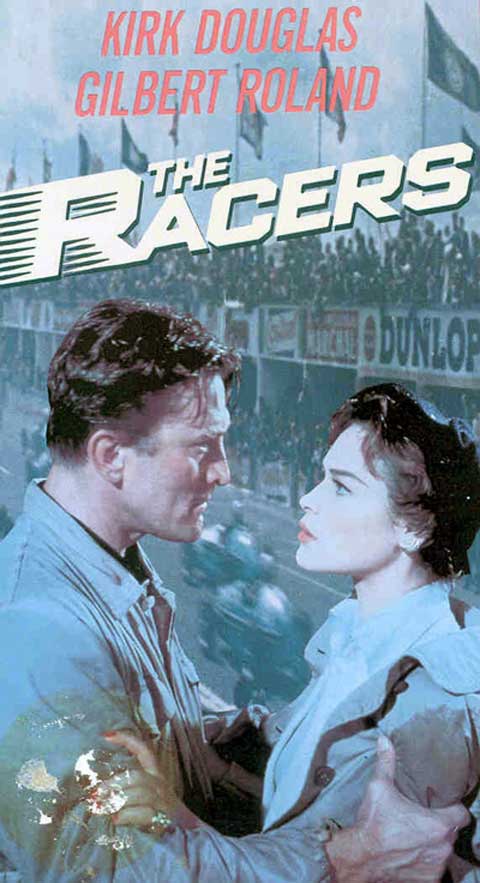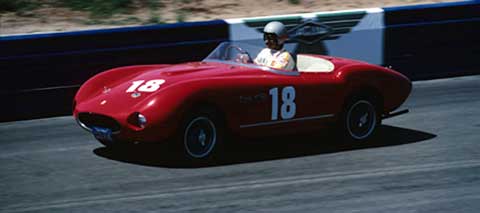 Crane negotiates Turn 9 (now Turn 11) with Arutunoff and the Cooper closing for the exit pass. The 166 would choke at the exit.
Crane negotiates Turn 9 (now Turn 11) with Arutunoff and the Cooper closing for the exit pass. The 166 would choke at the exit.
Last week Larry left us off at the very edge of Riverside Raceway. He continues below.
IGNITION: Fuel
The Ferrari Owners Club let me in even though our Ferrari didn’t survive the move for long. It transformed into a Mini 1275 S Mk II and an Alfa Giulietta Sprint Veloce. The Ferrari crowd became my California family. Some continue to be, 40 years later. A much-read library and developing track skills were my tickets in.
One balmy evening in late July of 1976, we were guests of Ferrari aficionado Edwin K. Niles, sharing his oft-used terrace with several other guests. As new friendships grew more comfortable, our host suggested that if anyone present would like to prepare and enter his newly acquired ’53 Ferrari spider in the Monterey Historics they were welcome to try. He was looking straight at me. As I caught my breath, I realized I had committed my life savings and all my time for the next three weeks to a small red machine that would give me one of the most memorable weekends of my life.
 The 166 2-liter engine was the same dimensions that eventually became the 250 3-liter. The three 4-barrel Webers were always a Wow!-sight when the hood went up.
The 166 2-liter engine was the same dimensions that eventually became the 250 3-liter. The three 4-barrel Webers were always a Wow!-sight when the hood went up.
In three weeks that thing (affectionately) received a comprehensive tune-up, most of a new nose, paint, brake work and miscellaneous tightenings and adjustings. Finally, as the last few minutes ticked away and dozens of tiny items were stashed into dozens of tiny spaces, Le Patron de l’Equipe arrived in a fly yellow 275GTB/C to observe the letting-out of his sparkling rosso cavallino. Also vital to the expedition were Mark and Sandy Schroeder’s USS Fleetwood Brougham, a thing of capacious dimensions that carried many bulky items impractical for even the combined space of two Ferraris.
In one old guy’s opinion, the only way to attend a vintage sports car race is to drive your racer. Most of the trip from L.A. to Monterey was through sun-baked valleys, but as they opened onto the Pacific the entire character of the trip changed. Finally, The Pacific Coast Highway. The temperature dropped, the cars cooled down, the drivers cooled down, the horsepower went up and the road began to roll and twist. Heaven. For the first time I could test the adhesion of the new Pirelli Centuratos, brake response, the long-dormant down-shift two-step and experience three four-barrel carbs feeding two-liters.
As I left the pump someone came running up to the car shouting “My car! My car! Where did you find my car?â€
If you don’t know the car, let me introduce you. It was the 166MM Series II, S/N 0272 M, used by Caccari and Mason in the 1953 Mille Miglia, but more famously as Gino Borghese’s (Kirk Douglas’) sports racer in the 1955 movie “The Racers.†(Read about The Racers). It was also entered in the 1954 event for the movie, driven by de Graffenried. You’ll see it as number 556 in the movie. The pointy (at both ends) little spyder was powered by a Colombo’s classic SOHC V-12, in two-liter form, fed by three Weber W36 IF4/C carbs, similar to those on the mighty 4.5-liter racers of the time. The design included a small cockpit wedged between the 35-gallon fuel tank and the long, mid-front V-12. A windscreen was provided to direct flying items above the eye line, but not the forehead. The stuff of fantasy.

Kirk Douglas played his manly self driving his Burano (the renamed Ferrari 166MM) in the movie and Bella Darvi was so beautiful no one asked if she was an actress. Do check the link for Pete’s review of “The Racers.†Some of us have seen it 20 times or more and still enjoy seeing all those heroes playing themselves.
The California coast at sunset in an open Ferrari roadster with the “song of the twelve†echoing off the cliffs and light, misty fog whistling around your ears, is enough to raise the heart rate of the most complacent enthusiast. Friday morning tech and practice would come early so the Carmel surf reduced the day’s exhilaration to a night of exhaustion.
Laguna Seca’s basin was filled with the throaty sounds of priceless artifacts being exercised as we caravanned across the bridge and down the hill into the paddock. The driver’s meeting was interrupted several times by enthusiastic crews making final adjustments to surviving bits of early combustion experiments. Bob Bondurant, the envy of every male past the age of puberty, tried to reduce the anxiety and freedom-of-information actions of 50 assembled neophytes, by drawing smooth skillful lines on a painted miniature of the racing circuit. Back to our cars, with a half-understood racing line an indistinct mental blur, we set off in line-astern behind Bondurant School instructors to see what it meant. As speeds increased, tired old suspensions (some on the cars) and a number of equivalent brain cells were stressed by fresh new engines, accompanied by a periodic series of dust clouds.
Open practice followed a brief session of bench-racing and recovery. Pushing up to our shared limits, the Ferrari began to exhibit its age. The right front wheel seemed to brake better and longer than its counterparts—in fact, it continued to be pretty effective when my foot had returned to the accelerator. Turn nine at the bottom of a long, sweeping down-hill run became very exciting indeed.
We had scrubbed off 20 mph or so when the front of the car entered the corner and I selected third gear and pressed on. No one spoke. For a long time. About that corner—never.
Friday evening opened an al fresco brake flush and rebuild shop with Allan Bishop in the dirt parking lot of the Los Laurels Inn out in Carmel Valley. After 20 years of collected crud had been removed and the cylinders had been finger-tip honed, the brakes worked on all four corners. We were ready. A great steak seasoned with laughter released the tension for a pre-race rest.
A dawn run back out Carmel Valley and over Laureles Grade to Laguna Seca verified the evening’s work. A few cold-track re-acquaintance laps just outside the limits Pirelli had intended, and I was ready for my first competition.
After warm-up I made a quick stop for a few gallons of Union 76 “Racing Fuel†at the paddock pump. As I left the pump someone came running up to the car shouting “My car! My car! Where did you find my car?†Since, to my knowledge, it was not stolen, I thought it appropriate to enquire what he meant. It was quickly explained that this panting guy was Pete Lovely, a famous and popular west coast racer who won the first race at Laguna Seca. It seems he had owned the 166 and drove it to and from races from his home in Tacoma, Washington. He had kept track of the car for a while then lost touch with it about 6 years before we met. He told us crazy racer stories for over an hour.
One I must repeat. It seems Pete always drove the car to and from the races, and during one event in Northern California the car in front of him on the grid stalled at the start. Pete stopped just in time, but the car behind did not. He gave the 166 a mighty shunt and pushed it into the car in front destroying both of its elegantly pointed ends. Not deterred, Pete ran the race and drove the inelegantly shortened roadster back to Tacoma — through a snow storm. My challenges seemed pretty minor.
The race was great fun. Once underway Anatoly Arutunoff, [also a contributor to VeloceToday–ed.] had his Cooper MG right on my tail. The 166 could gain ground all the way to up the hill to the top of the corkscrew, but coming down through the twists to the acute angle of Turn Nine he would close right up against us. As we made the exit onto the front straight he would make a one car-length pass while the Ferrari choked and gagged under full throttle. Once clear we could re-pass by turn two and pull away on the run back up to the corkscrew. On the last lap, experience won. Toly came up inside Turn Nine under braking and led by one additional car length onto the front straight. I was looking in his cockpit at the checker.
 The nose of the car was dramatically improved after its racing start shunt. It is still an active participant in vintage racing and remains one of the prettiest of the early Ferrari roadsters.
The nose of the car was dramatically improved after its racing start shunt. It is still an active participant in vintage racing and remains one of the prettiest of the early Ferrari roadsters.
After a great Ferrari party Saturday night and sharing the Pebble Beach lawn with the stars, we refilled the 35-gallon tank and headed south on Monday morning. Highway 1 was just too compelling to ignore for a last drive in the historic roadster. The road traversed a long alluvial fan and old-growth woods before returning to the coast through a right-left sequence of turns divided by a few hundred meters of straight. With confidence in the car’s dynamics buoyed by track experience, I entered the right turn faster than I would have on the preceding Thursday. When were driving north we had reached the northern end of the challenging coastal route late in the day and had burned off most of the 35 gallons of fuel. But heading south with a full tank of about 216 pounds of fluid in the tail it simply rotated. With a quick correction we stopped rotating but continued perpendicular to the road still traveling at something like 70mph and approaching a left turn pointed exactly the wrong direction. The outside of that left turn was a cliff dropping several hundred feet to a rocky coast—we would be there in seconds. My wife and I made eye contact. I simply mouthed, “I’m sorry.”
Action. Try hand brake. Try full lock left with light foot brake. Touch hand brake again. More foot brake. Take one breath—it’s been a while. A little more hand brake. Finally, slowly, (probably nano seconds) the tail began to follow the nose. The corner was upon us as the car continued to rotate again, this time with the tail moving to our right. We had scrubbed off 20 mph or so when the front of the car entered the corner and I selected third gear and pressed on. No one spoke. For a long time. About that corner—never.
A fabulous, fantasy weekend was burned into memory by what I did not know more than by what I had learned. I was invited to drive a dozen or more priceless cars over the next 30 years. Rarely lower than fourth or fifth on track, but never higher than “in control†on the road.
Life is sweet.
To be continued
I sold the Cooper-MH therough a broker who shall not be named to Admiral Hank Giffen, USN(Ret). It was a wonderful car, with the best throttle/clutch/gearbox action I’ve ever driven. But as I was assembling the paperwork to send to Admiral Hank, I found the letter from the previous owner, who’d bored out and rebuilt the engine with the famous DG3 cam–neither I nor anyone else seem to know about that cam any more. Turns out the redline I’d been using for my 18 years of ownership was the BREAK-IN limit! I always wondered why it felt like it was coming on the cam just as I’d upshift….
Well okay, I was shifting at 5000 on an engine that produced 130 horsepower at 6000 and had no redline. We’re even. I can still remember seeing your cloth Morgan badge glued onto the front of your helmet in my mirror. Where ever you were shifting, the Cooper was fun to watch. I hope Admiral Hank is still racing it.
I have to say that 0272MM provided me with some enjoyable moments while in the custody of Ed. I had the pleasure of undertaking some mechanical work on the car prior to Monterey, including the rebuild of the Weber 36 IF4/C carburetors. I recall that at one point, I had 0260MM, 0272MM and 0274MM all in my shop together. A test run up Santa Ynez canyon was punctuated by the sudden loss of the right-hand exhaust pipe! Later, at the Historics, I was attendant to one of the myriad post-race parties, along with Ed and Larry. By some long-forgotten set of circumstances, I was left stranded at the party with no way back to my hotel in Carmel. Reluctantly, but with a smile, Ed handed me the Marelli key to the 166, while Larry admonished me to have thee car at the track next day….and that right early! The drive home on a moonless, very foggy night on back roads was, and will remain, unforgettable….gone are the days. Yes…the car was in the paddock by 8:00AM the next morning.
I don’t recall you swapping ends on the trip home, but I do remember that I left the cold plugs in the engine, and that they would gradually oil up on Highway 101. A blast down a side road would temporarily cure that illness.
Yeah, these little 166 cars wouldn’t detach your retinas on acceleration, and the brakes…well, as Phil Hill told me, the drums were for coming up to a stop – slowing down was done via downshifting!